
Appendix B – ATtiny13A Specification at 125°C
This document contains information specific to devices operating at temperatures up
to 125°C. Only deviations are covered in this appendix, all other information can be
found in the complete datasheet. The complete datasheet can be found at
www.atmel.com.
8-bit
Microcontroller
with 1K Bytes
In-System
Programmable
Flash
ATtiny13A
Appendix B
Rev. 8126F-Appendix B–AVR–05/12
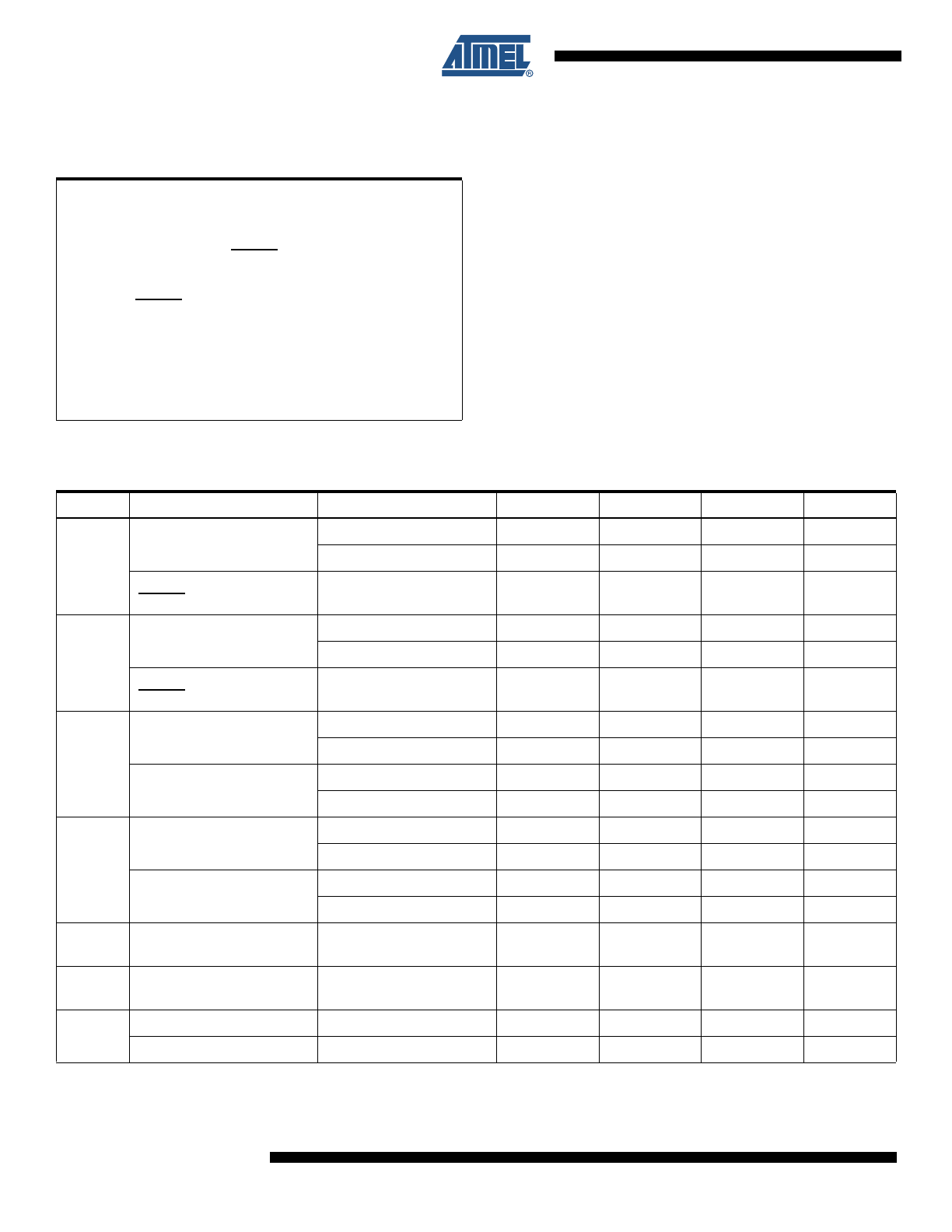
2
8126F-Appendix B–AVR–05/12
ATtiny13A
1.
Electrical Characteristics
1.1
Absolute Maximum Ratings*
1.2
DC Characteristics
Operating Temperature.................................. -55°C to +125°C
*NOTICE:
Stresses beyond those listed under “Absolute
Maximum Ratings” may cause permanent dam-
age to the device. This is a stress rating only and
functional operation of the device at these or
other conditions beyond those indicated in the
operational sections of this specification is not
implied. Exposure to absolute maximum rating
conditions for extended periods may affect
device reliability.
Storage Temperature ..................................... -65°C to +150°C
Voltage on any Pin except RESET
with respect to Ground ................................-0.5V to V
CC
+0.5V
Voltage on RESET with respect to Ground......-0.5V to +13.0V
Maximum Operating Voltage ............................................ 6.0V
DC Current per I/O Pin ............................................... 40.0 mA
DC Current V
CC
and GND Pins ................................ 200.0 mA
Table 1-1.
DC Characteristics, T
A
= -40°C to +125°C
Symbol
Parameter
Condition
Min
Typ
(1)
Max
Units
V
IL
Input Low Voltage,
Any Pin as I/O
V
CC
= 1.8 - 2.4V
-0.5
0.2V
CC
(2)
V
V
CC
= 2.4 - 5.5V
-0.5
0.3V
CC
(2)
V
Input Low Voltage,
RESET Pin as Reset
(4)
V
CC
= 1.8 - 5.5V
-0.5
0.2V
CC
(2)
V
V
IH
Input High Voltage,
Any Pin as I/O
V
CC
= 1.8 - 2.4V
0.7V
CC
(3)
V
CC
+ 0.5
V
V
CC
= 2.4 - 5.5V
0.6V
CC
(3)
V
CC
+ 0.5
V
Input High Voltage,
RESET Pin as Reset
(4)
V
CC
= 1.8 - 5.5V
0.9V
CC
(3)
V
CC
+ 0.5
V
V
OL
Output Low Voltage,
Pins PB0 and PB1
(5)
I
OL
= 20 mA, V
CC
= 5V
0.9
V
I
OL
= 10 mA, V
CC
= 3V
0.7
V
Output Low Voltage,
Pins PB2, PB3 and PB4
(5)
I
OL
= 10 mA, V
CC
= 5V
0.8
V
I
OL
= 5 mA, V
CC
= 3V
0.6
V
V
OH
Output High Voltage,
Pins PB0 and PB1
(6)
I
OH
= -20 mA, V
CC
= 5V
4.0
V
I
OH
= -10 mA, V
CC
= 3V
2.3
V
Output High Voltage,
Pins PB2, PB3 and PB4
(6)
I
OH
= -10 mA, V
CC
= 5V
4.2
V
I
OH
= -5 mA, V
CC
= 3V
2.5
V
I
LIL
Input Leakage
Current I/O Pin
V
CC
= 5.5V, pin low
-1
1
µA
I
LIH
Input Leakage
Current I/O Pin
V
CC
= 5.5V, pin high
-1
1
µA
R
PU
Pull-Up Resistor, I/O Pin
V
CC
= 5.5V, input low
20
50
k
Ω
Pull-Up Resistor, Reset Pin
V
CC
= 5.5V, input low
30
80
k
Ω

3
8126F-Appendix B–AVR–05/12
ATtiny13A
Notes:
1. Typical values at +25°C.
2. “Max” means the highest value where the pin is guaranteed to be read as low.
3. “Min” means the lowest value where the pin is guaranteed to be read as high.
4. Not tested in production.
5. Although each I/O port can under non-transient, steady state conditions sink more than the test conditions, the sum of all I
OL
(for all ports) should not exceed 60 mA. If I
OL
exceeds the test condition, V
OL
may exceed the related specification. Pins are
not guaranteed to sink current greater than the listed test condition.
6. Although each I/O port can under non-transient, steady state conditions source more than the test conditions, the sum of all
I
OH
(for all ports) should not exceed 60 mA. If I
OH
exceeds the test condition, V
OH
may exceed the related specification. Pins
are not guaranteed to source current greater than the listed test condition.
7. Values are with external clock. Power Reduction is enabled (PRR = 0xFF) and there is no I/O drive.
8. BOD Disabled.
1.3
Clock Characteristics
1.3.1
Accuracy of Calibrated Internal Oscillator
It is possible to manually calibrate the internal oscillator to be more accurate than default factory calibration. Note that the
oscillator frequency depends on temperature and voltage. Voltage and temperature characteristics can be found in
Figure
2-53 on page 32
,
Figure 2-54 on page 33
,
Figure 2-55 on page 33
, and in
Figure 2-56 on page 34
.
Notes:
1. Accuracy of oscillator frequency at calibration point (fixed temperature and fixed voltage).
I
CC
Supply Current,
Active Mode
(7)
f = 1MHz, V
CC
= 2V
0.2
0.35
mA
f = 4MHz, V
CC
= 3V
1.2
1.8
mA
f = 8MHz, V
CC
= 5V
3.6
6
mA
Supply Current,
Idle Mode
(7)
f = 1MHz, V
CC
= 2V
0.03
0.2
mA
f = 4MHz, V
CC
= 3V
0.2
1
mA
f = 8MHz, V
CC
= 5V
0.7
3
mA
Supply Current,
Power-Down Mode
(8)
WDT enabled, V
CC
= 3V
3.9
20
µA
WDT disabled, V
CC
= 3V
0.15
10
µA
Table 1-1.
DC Characteristics, T
A
= -40°C to +125°C (Continued)
Symbol
Parameter
Condition
Min
Typ
(1)
Max
Units
Table 1-2.
Calibration Accuracy of Internal Oscillator
Calibration
Method
Target Frequency
V
CC
Temperature
Accuracy at given Voltage
& Temperature
(1)
Factory
Calibration
4.8 / 9.6 MHz
3V
25°C
±10%
User
Calibration
Fixed frequency within:
4 – 5 MHz / 8 – 10 MHz
Fixed voltage within:
1.8 – 5.5V
Fixed temperature
within:
-40°C to +125°C
±2%
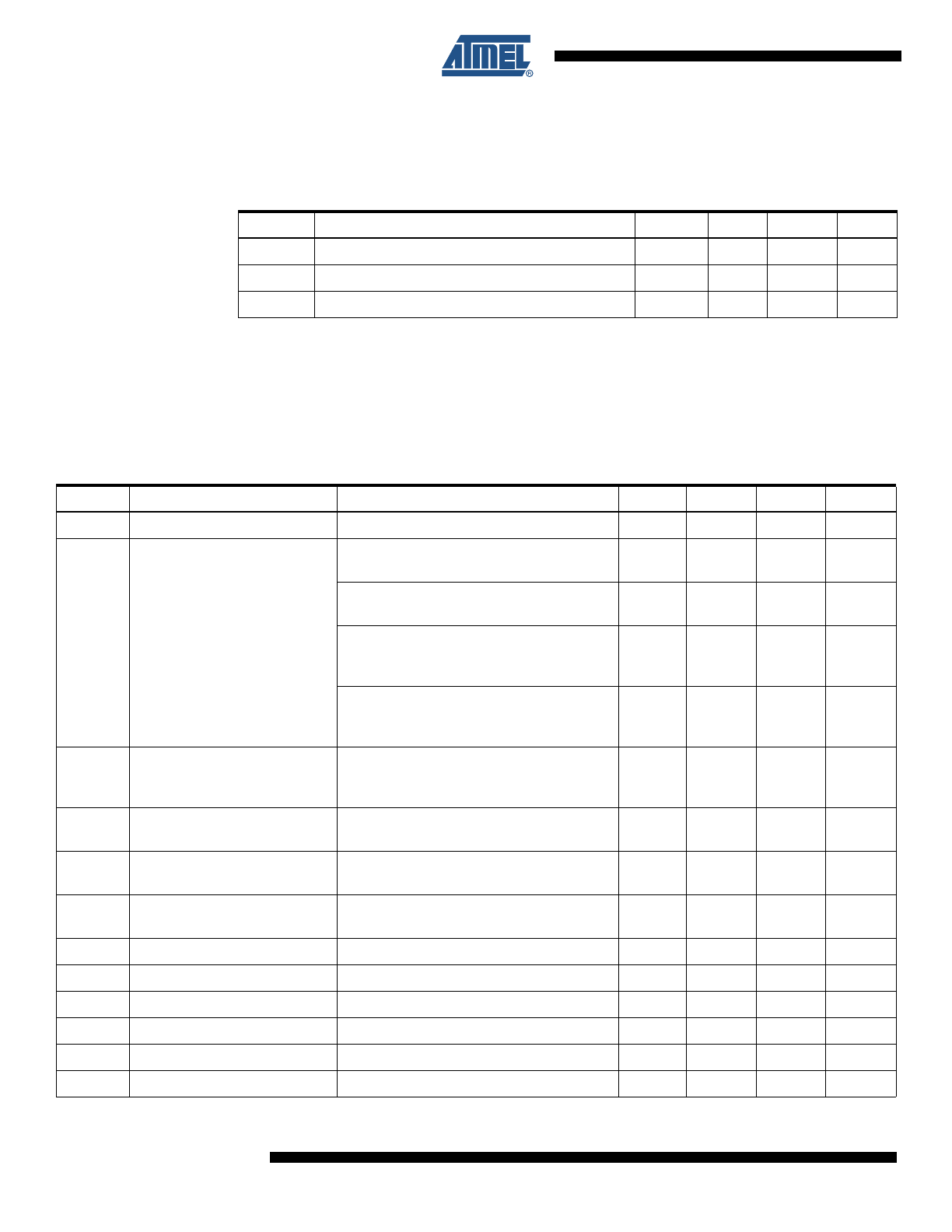
4
8126F-Appendix B–AVR–05/12
ATtiny13A
1.4
System and Reset Characteristics
1.4.1
Enhanced Power-On Reset
Note:
1. Values are guidelines only.
2. Threshold where device is released from reset when voltage is rising.
3. The Power-on Reset will not work unless the supply voltage has been below V
POA
.
1.5
ADC Characteristics
Table 1-3.
Characteristics of Enhanced Power-On Reset. T
A
= -40 to +125°C
Symbol
Parameter
Min
(1)
Typ
(1)
Max
(1)
Units
V
POR
Release threshold of power-on reset
(2)
1.1
1.4
1.7
V
V
POA
Activation threshold of power-on reset
(3)
0.6
1.3
1.7
V
SR
ON
Power-On Slope Rate
0.01
V/ms
Table 1-4.
ADC Characteristics, Single Ended Channels. T
A
= -40°C to +125°C
Symbol
Parameter
Condition
Min
Typ
Max
Units
Resolution
10
Bits
Absolute accuracy
(Including INL, DNL, and
Quantization, Gain and Offset
Errors)
V
REF
= 4V, V
CC
= 4V,
ADC clock = 200 kHz
3
LSB
V
REF
= 4V, V
CC
= 4V,
ADC clock = 1 MHz
4
LSB
V
REF
= 4V, V
CC
= 4V,
ADC clock = 200 kHz,
Noise Reduction Mode
2.5
LSB
V
REF
= 4V, V
CC
= 4V,
ADC clock = 1 MHz,
Noise Reduction Mode
3.5
LSB
Integral Non-Linearity (INL)
(Accuracy after Offset and
Gain Calibration)
V
REF
= 4V, V
CC
= 4V,
ADC clock = 200 kHz
1
LSB
Differential Non-linearity
(DNL)
V
REF
= 4V, V
CC
= 4V,
ADC clock = 200 kHz
0.5
LSB
Gain Error
V
REF
= 4V, V
CC
= 4V,
ADC clock = 200 kHz
3.5
LSB
Offset Error
V
REF
= 4V, V
CC
= 4V,
ADC clock = 200 kHz
2.5
LSB
Conversion Time
Free Running Conversion
13
260
µs
Clock Frequency
50
1000
kHz
V
IN
Input Voltage
GND
V
REF
V
Input Bandwidth
38.5
kHz
V
INT
Internal Voltage Reference
1.0
1.1
1.2
V
R
AIN
Analog Input Resistance
100
M
Ω
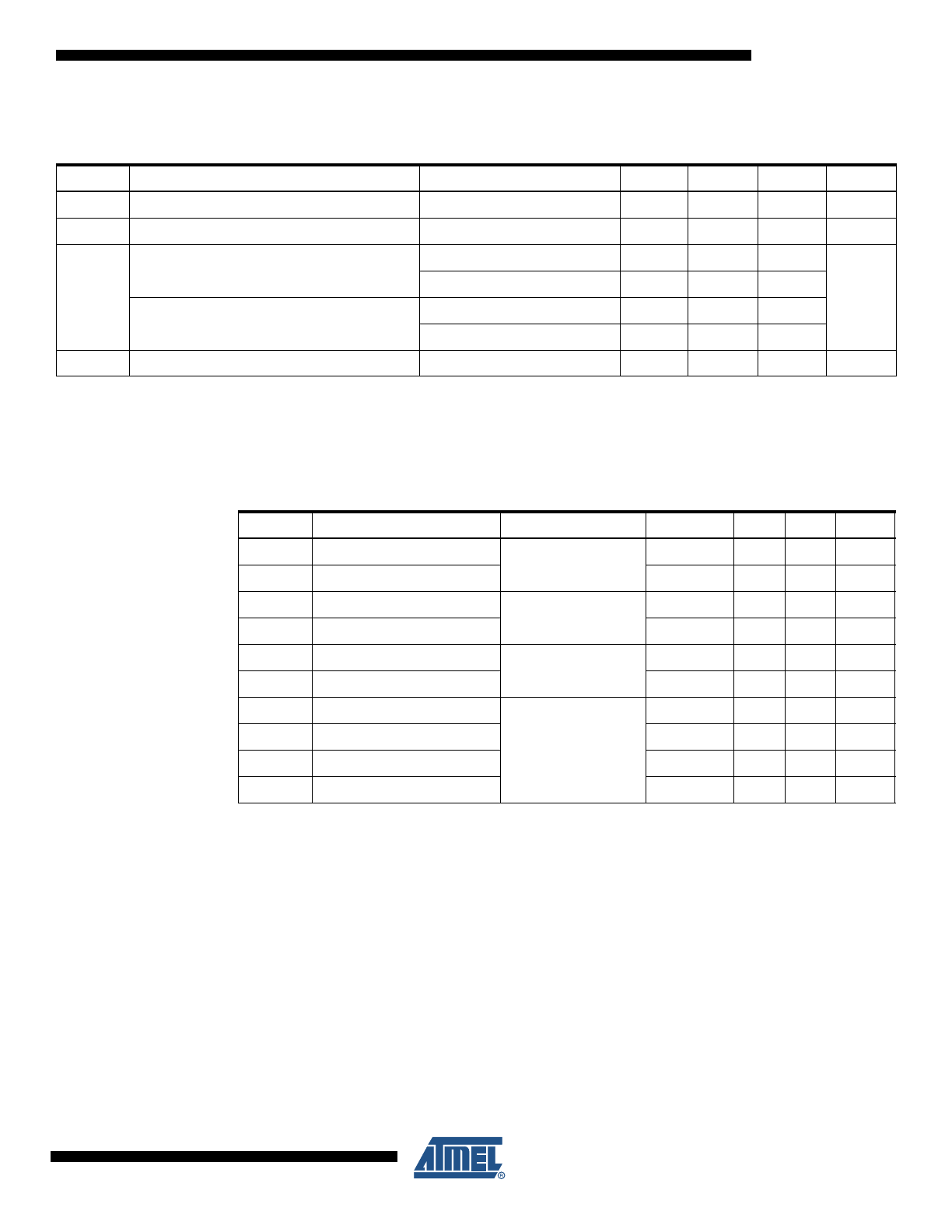
5
8126F-Appendix B–AVR–05/12
ATtiny13A
1.6
Analog Comparator Characteristics
Note:
All parameters are based on simulation results.
1.7
Serial Programming Characteristics
Note:
1. 2 t
CLCL
for f
ck
< 12 MHz, 3 t
CLCL
for f
ck
>= 12 MHz
Table 1-5.
Analog Comparator Characteristics, T
A
= -40°C to +125°C
Symbol
Parameter
Condition
Min
Typ
Max
Units
V
AIO
Input Offset Voltage
V
CC
= 5V, V
IN
= V
CC
/ 2
< 10
40
mV
I
LAC
Input Leakage Current
V
CC
= 5V, V
IN
= V
CC
/ 2
-250
250
nA
t
APD
Analog Propagation Delay
(from saturation to slight overdrive)
V
CC
= 2.7V
750
ns
V
CC
= 4.0V
500
Analog Propagation Delay
(large step change)
V
CC
= 2.7V
100
V
CC
= 4.0V
75
t
DPD
Digital Propagation Delay
V
CC
= 1.8 - 5.5V
1
2
CLK
Table 1-6.
Serial Programming Characteristics, T
A
= -40°C to +125°C
Symbol
Parameter
Condition
Min
Typ
Max
Units
1/t
CLCL
Oscillator Frequency
V
CC
= 1.8 – 5.5V
0
1
MHz
t
CLCL
Oscillator Period
1000
ns
1/t
CLCL
Oscillator Frequency
V
CC
= 2.7 – 5.5V
0
9.6
MHz
t
CLCL
Oscillator Period
104
ns
1/t
CLCL
Oscillator Frequency
V
CC
= 4.5 – 5.5V
0
20
MHz
t
CLCL
Oscillator Period
50
ns
t
SHSL
SCK Pulse Width High
V
CC
= 1.8 – 5.5V
2 t
CLCL
(1)
ns
t
SLSH
SCK Pulse Width Low
2 t
CLCL
(1)
ns
t
OVSH
MOSI Setup to SCK High
t
CLCL
ns
t
SHOX
MOSI Hold after SCK High
2 t
CLCL
ns
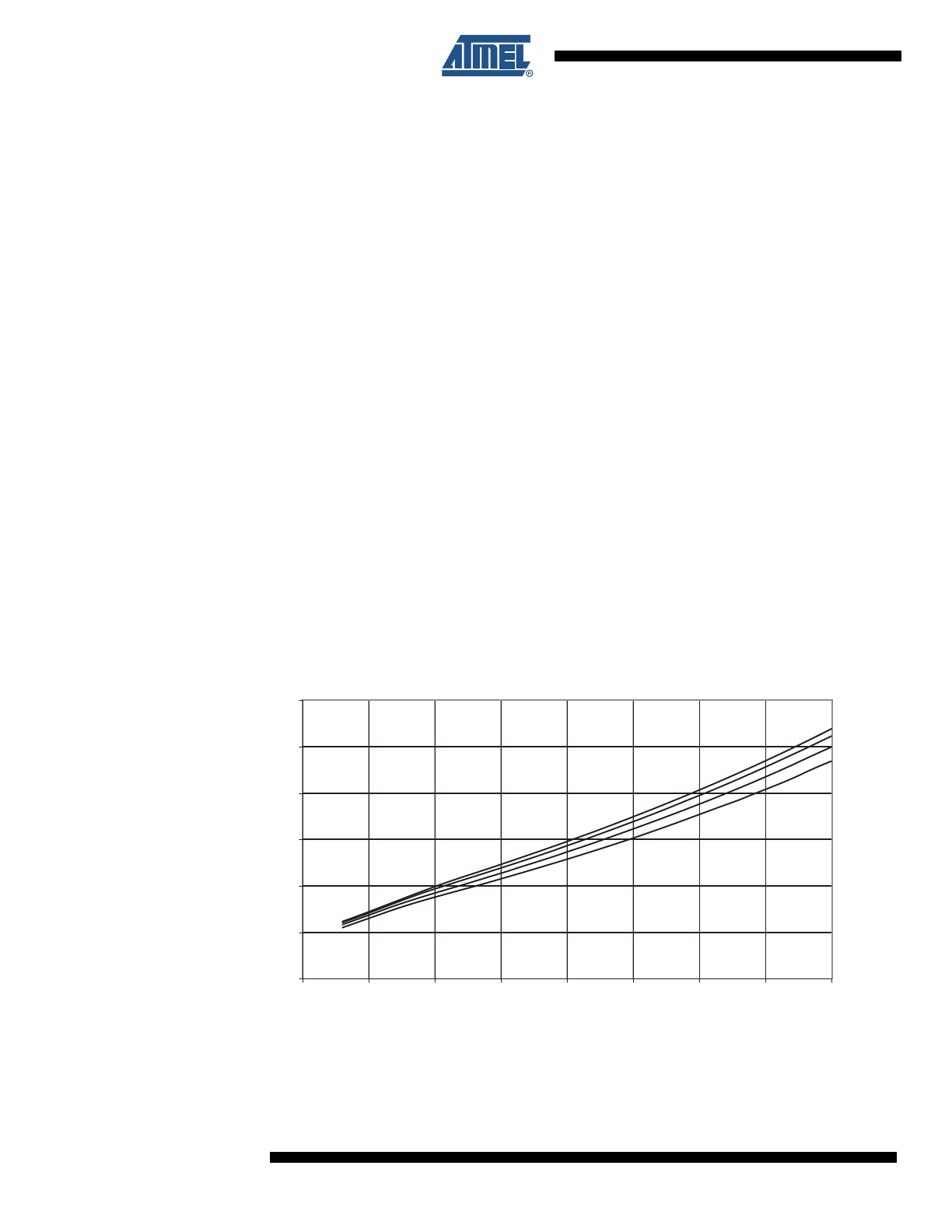
6
8126F-Appendix B–AVR–05/12
ATtiny13A
2.
Typical Characteristics
The data contained in this section is largely based on simulations and characterization of similar
devices in the same process and design methods. Thus, the data should be treated as indica-
tions of how the part will behave.
The following charts show typical behavior. These figures are not tested during manufacturing.
During characterisation devices are operated at frequencies higher than test limits but they are
not guaranteed to function properly at frequencies higher than the ordering code indicates.
All current consumption measurements are performed with all I/O pins configured as inputs and
with internal pull-ups enabled. Current consumption is a function of several factors such as oper-
ating voltage, operating frequency, loading of I/O pins, switching rate of I/O pins, code executed
and ambient temperature. The dominating factors are operating voltage and frequency.
A sine wave generator with rail-to-rail output is used as clock source but current consumption in
Power-Down mode is independent of clock selection. The difference between current consump-
tion in Power-Down mode with Watchdog Timer enabled and Power-Down mode with Watchdog
Timer disabled represents the differential current drawn by the Watchdog Timer.
The current drawn from pins with a capacitive load may be estimated (for one pin) as follows:
where V
CC
= operating voltage, C
L
= load capacitance and f
SW
= average switching frequency of
I/O pin.
2.1
Current Consumption in Active Mode
Figure 2-1.
Active Supply Current vs. V
CC
(Internal Calibrated Oscillator, 9.6 MHz)
I
CP
V
CC
C
L
f
×
×
SW
≈
ACTIVE SUPPLY CURRENT vs. V
CC
INTERNAL OSCILLATOR, 9.6 MHz
125 °C
85 °C
25 °C
-40 °C
0
1
2
3
4
5
6
1,5
2
2,5
3
3,5
4
4,5
5
5,5
V
CC
(V)
I
CC
(mA)

7
8126F-Appendix B–AVR–05/12
ATtiny13A
Figure 2-2.
Active Supply Current vs. V
CC
(Internal Calibrated Oscillator, 4.8 MHz)
Figure 2-3.
Active Supply Current vs. V
CC
(Internal WDT Oscillator, 128 kHz)
ACTIVE SUPPLY CURRENT vs. V
CC
INTERNAL OSCILLATOR, 4.8 MHz
125 °C
85 °C
25 °C
-40 °C
0
0,5
1
1,5
2
2,5
3
3,5
1,5
2
2,5
3
3,5
4
4,5
5
5,5
V
CC
(V)
I
CC
(mA)
ACTIVE SUPPLY CURRENT vs. V
CC
INTERNAL OSCILLATOR, 128 kHz
125 °C
85 °C
25 °C
-40 °C
0
0,02
0,04
0,06
0,08
0,1
0,12
1,5
2
2,5
3
3,5
4
4,5
5
5,5
V
CC
(V)
I
CC
(mA)

8
8126F-Appendix B–AVR–05/12
ATtiny13A
Figure 2-4.
Active Supply Current vs. V
CC
(32 kHz External Clock)
2.2
Current Consumption in Idle Mode
Figure 2-5.
Idle Supply Current vs. V
CC
(Internal Calibrated Oscillator, 9.6 MHz)
ACTIVE SUPPLY CURRENT vs. V
CC
32 KHz EXTERNAL CLOCK, PRR = 0xFF
125 °C
85 °C
25 °C
-40 °C
0
0,005
0,01
0,015
0,02
0,025
0,03
1,5
2
2,5
3
3,5
4
4,5
5
5,5
V
CC
(V)
I
CC
(mA)
IDLE SUPPLY CURRENT vs. V
CC
INTERNAL OSCILLATOR, 9.6 MHz
125 °C
85 °C
25 °C
-40 °C
0
0,2
0,4
0,6
0,8
1
1,2
1,4
1,6
1,5
2
2,5
3
3,5
4
4,5
5
5,5
V
CC
(V)
ICC (mA)

9
8126F-Appendix B–AVR–05/12
ATtiny13A
Figure 2-6.
Idle Supply Current vs. V
CC
(Internal Calibrated Oscillator, 4.8 MHz)
Figure 2-7.
Idle Supply Current vs. V
CC
(Internal Oscillator, 128 kHz)
IDLE SUPPLY CURRENT vs. V
CC
INTERNAL OSCILLATOR, 4.8 MHz
125 °C
85 °C
25 °C
-40 °C
0
0,1
0,2
0,3
0,4
0,5
0,6
0,7
1,5
2
2,5
3
3,5
4
4,5
5
5,5
V
CC
(V)
I
CC
(mA)
IDLE SUPPLY CURRENT vs. V
CC
INTERNAL OSCILLATOR, 128 kHz
125 °C
85 °C
25 °C
-40 °C
0
0,005
0,01
0,015
0,02
0,025
1,5
2
2,5
3
3,5
4
4,5
5
5,5
V
CC
(V)
I
CC
(mA)
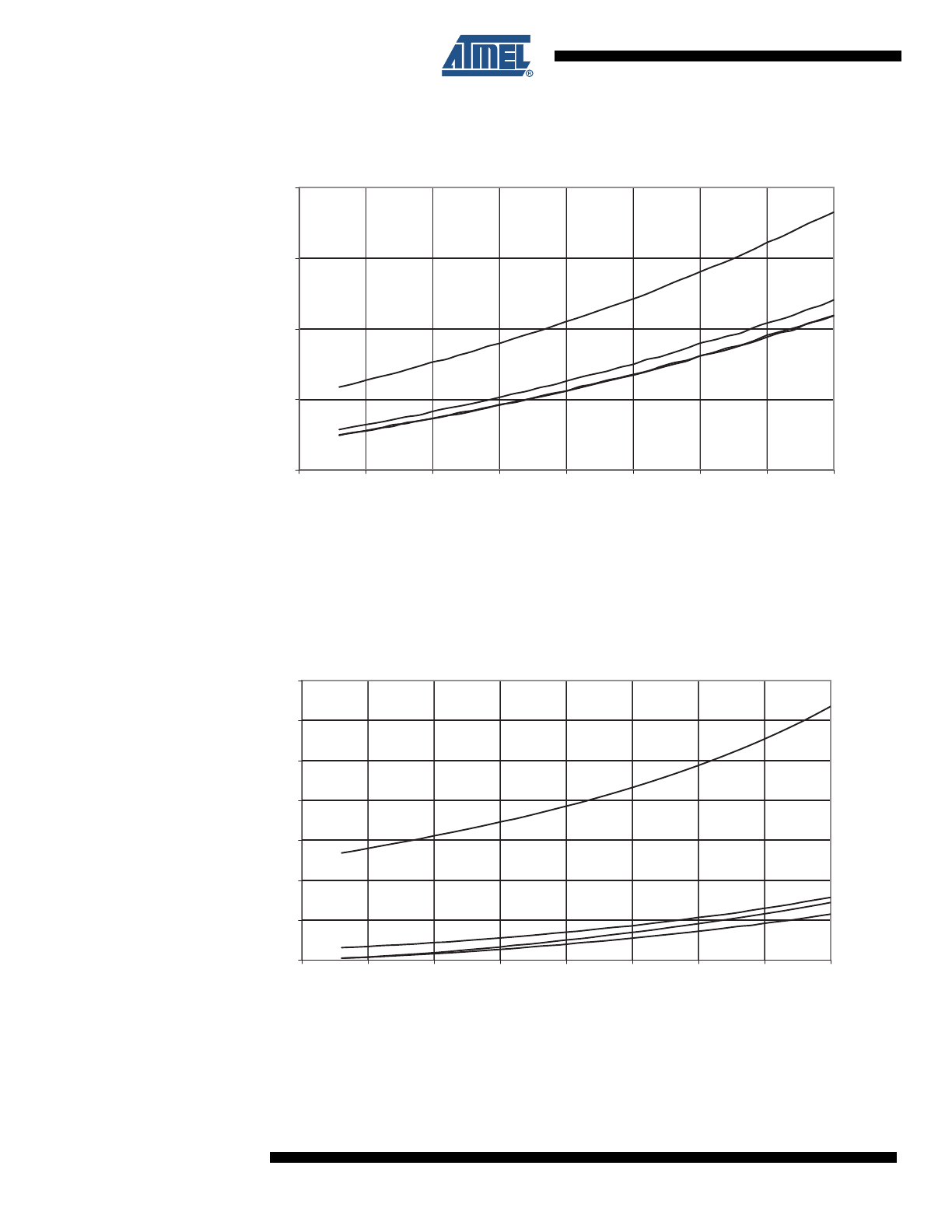
10
8126F-Appendix B–AVR–05/12
ATtiny13A
Figure 2-8.
Idle Supply Current vs. V
CC
(32 kHz External Clock)
2.3
Current Consumption in Power-down Mode
Figure 2-9.
Power-down Supply Current vs. V
CC
(Watchdog Timer Disabled)
IDLE SUPPLY CURRENT vs. V
CC
32 KHz EXTERNAL OSCILLATOR, PRR=0xFF
125 °C
85 °C
25 °C
-40 °C
0
0,002
0,004
0,006
0,008
1,5
2
2,5
3
3,5
4
4,5
5
5,5
V
CC
(V)
I
CC
(mA)
POWER-DOWN SUPPLY CURRENT vs. V
CC
WATCHDOG TIMER DISABLED
125 °C
85 °C
25 °C
-40 °C
0
0,5
1
1,5
2
2,5
3
3,5
1,5
2
2,5
3
3,5
4
4,5
5
5,5
V
CC
(V)
I
CC
(uA)
